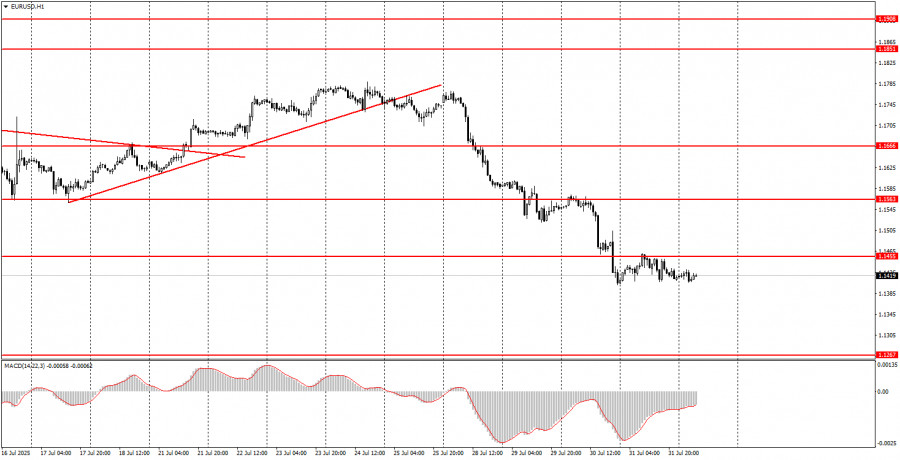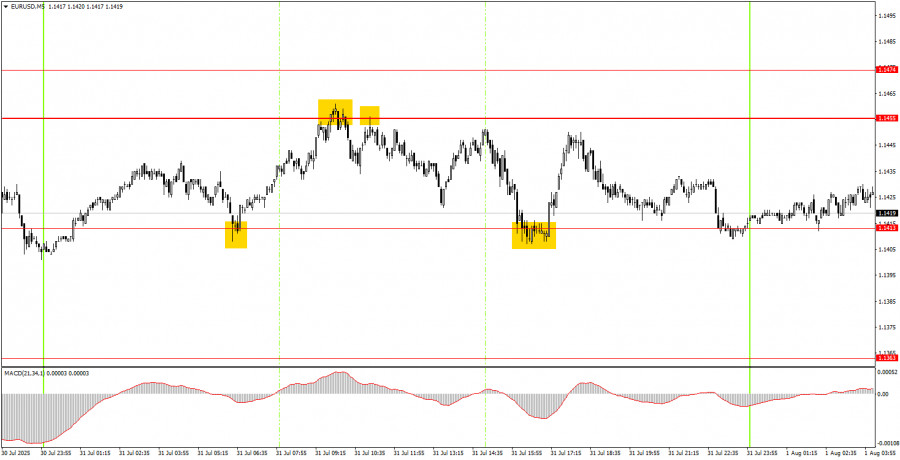Analysis of Thursday's Trades
1H Chart of EUR/USD
The EUR/USD currency pair paused for a "break" on Thursday, which was quite expected. The macroeconomic background on Thursday was very weak, although the event calendar included many seemingly interesting entries. However, unemployment rates in Germany and the European Union remained unchanged compared to the previous month, as did the inflation rate in Germany. In the U.S., only secondary reports were published. As a result, there was virtually no movement in the market yesterday. The downward trend in the euro remains intact, which fully aligns with the macroeconomic and fundamental background of this week. Now all that remains is to see the data on unemployment, the labor market, and business activity in the U.S., which could trigger a new "storm" in the market. The dollar may well continue to rise today if the above reports turn out to be favorable for the dollar, just like all the other data this week.
5M Chart of EUR/USD
In the 5-minute time frame, the price stayed in a tight flat range between 1.1413 and 1.1455 on Thursday. Four trading signals were generated at the boundaries of this range, and each time the price reached or nearly reached the opposite boundary. Thus, novice traders could have opened three trades, each of which would have ended in a small but positive profit.
Trading Strategy for Friday:
In the hourly time frame, the EUR/USD pair has resumed its downward corrective movement, supported by news of the agreement between the EU and the U.S., strong U.S. GDP data, and Jerome Powell's rhetoric. Since Donald Trump's policy has not changed recently and the issues of confrontation with Powell and the trade war remain relevant, we still do not see any medium-term reason for the dollar to appreciate. Therefore, the dollar may continue rising in the short term, but in the long term, it is unlikely.
On Friday, the EUR/USD pair may move in either direction, as U.S. macroeconomic data will take center stage today. From a technical perspective, the levels 1.1413 and 1.1455 remain relevant for identifying trading signals. The flat phase has not yet ended.
On the 5-minute time frame, the following levels should be considered: 1.1198–1.1218, 1.1267–1.1292, 1.1354–1.1363, 1.1413, 1.1455–1.1474, 1.1527, 1.1563–1.1571, 1.1655–1.1666, 1.1740–1.1745, 1.1808, 1.1851, 1.1908.
In the Eurozone, inflation data is scheduled for release on Friday, but it is unlikely to attract much attention from traders. The U.S. reports on unemployment, the labor market, and business activity are the key data points on this final trading day of the week.
Core Trading System Rules:
- Signal Strength: The shorter the time it takes for a signal to form (a rebound or breakout), the stronger the signal.
- False Signals: If two or more trades near a level result in false signals, subsequent signals from that level should be ignored.
- Flat Markets: In flat conditions, pairs may generate many false signals or none at all. It's better to stop trading at the first signs of a flat market.
- Trading Hours: Open trades between the start of the European session and the middle of the US session, then manually close all trades.
- MACD Signals: On the hourly timeframe, trade MACD signals only during periods of good volatility and a clear trend confirmed by trendlines or trend channels.
- Close Levels: If two levels are too close (5–20 pips apart), treat them as a support or resistance zone.
- Stop Loss: Set a Stop Loss to breakeven after the price moves 15 pips in the desired direction.
Key Chart Elements:
Support and Resistance Levels: These are target levels for opening or closing positions and can also serve as points for placing Take Profit orders.
Red Lines: Channels or trendlines indicating the current trend and the preferred direction for trading.
MACD Indicator (14,22,3): A histogram and signal line used as a supplementary source of trading signals.
Important Events and Reports: Found in the economic calendar, these can heavily influence price movements. Exercise caution or exit the market during their release to avoid sharp reversals.
Forex trading beginners should remember that not every trade will be profitable. Developing a clear strategy and practicing proper money management are essential for long-term trading success.














